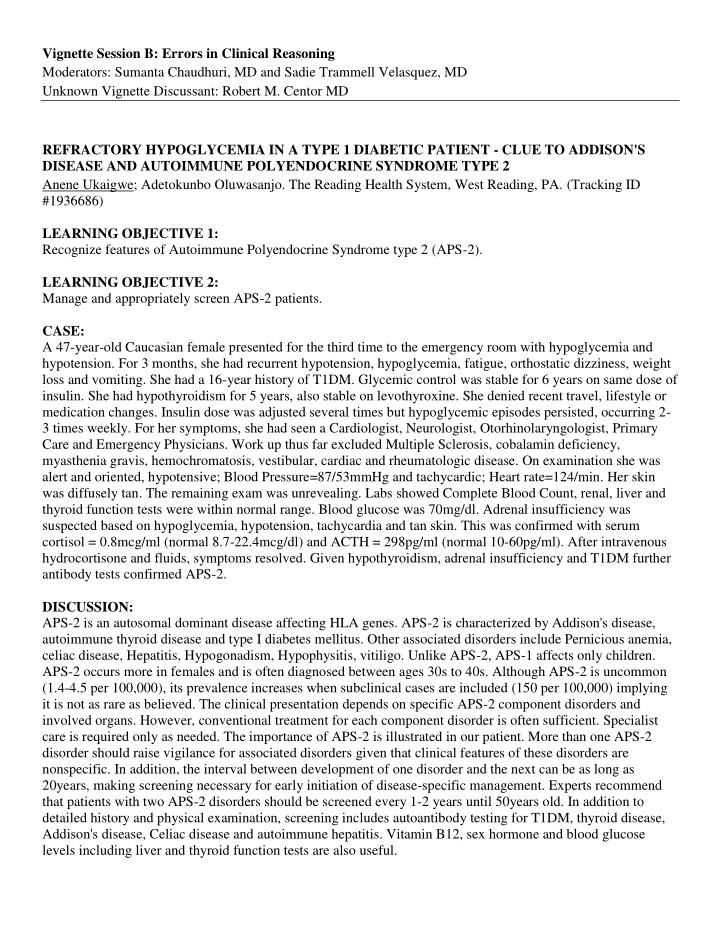



Vignette Session B: Errors in Clinical Reasoning Moderators: Sumanta Chaudhuri, MD and Sadie Trammell Velasquez, MD Unknown Vignette Discussant: Robert M. Centor MD REFRACTORY HYPOGLYCEMIA IN A TYPE 1 DIABETIC PATIENT - CLUE TO ADDISON'S DISEASE AND AUTOIMMUNE POLYENDOCRINE SYNDROME TYPE 2 Anene Ukaigwe; Adetokunbo Oluwasanjo. The Reading Health System, West Reading, PA. (Tracking ID #1936686) LEARNING OBJECTIVE 1: Recognize features of Autoimmune Polyendocrine Syndrome type 2 (APS-2). LEARNING OBJECTIVE 2: Manage and appropriately screen APS-2 patients. CASE: A 47-year-old Caucasian female presented for the third time to the emergency room with hypoglycemia and hypotension. For 3 months, she had recurrent hypotension, hypoglycemia, fatigue, orthostatic dizziness, weight loss and vomiting. She had a 16-year history of T1DM. Glycemic control was stable for 6 years on same dose of insulin. She had hypothyroidism for 5 years, also stable on levothyroxine. She denied recent travel, lifestyle or medication changes. Insulin dose was adjusted several times but hypoglycemic episodes persisted, occurring 2- 3 times weekly. For her symptoms, she had seen a Cardiologist, Neurologist, Otorhinolaryngologist, Primary Care and Emergency Physicians. Work up thus far excluded Multiple Sclerosis, cobalamin deficiency, myasthenia gravis, hemochromatosis, vestibular, cardiac and rheumatologic disease. On examination she was alert and oriented, hypotensive; Blood Pressure=87/53mmHg and tachycardic; Heart rate=124/min. Her skin was diffusely tan. The remaining exam was unrevealing. Labs showed Complete Blood Count, renal, liver and thyroid function tests were within normal range. Blood glucose was 70mg/dl. Adrenal insufficiency was suspected based on hypoglycemia, hypotension, tachycardia and tan skin. This was confirmed with serum cortisol = 0.8mcg/ml (normal 8.7-22.4mcg/dl) and ACTH = 298pg/ml (normal 10-60pg/ml). After intravenous hydrocortisone and fluids, symptoms resolved. Given hypothyroidism, adrenal insufficiency and T1DM further antibody tests confirmed APS-2. DISCUSSION: APS-2 is an autosomal dominant disease affecting HLA genes. APS-2 is characterized by Addison's disease, autoimmune thyroid disease and type I diabetes mellitus. Other associated disorders include Pernicious anemia, celiac disease, Hepatitis, Hypogonadism, Hypophysitis, vitiligo. Unlike APS-2, APS-1 affects only children. APS-2 occurs more in females and is often diagnosed between ages 30s to 40s. Although APS-2 is uncommon (1.4-4.5 per 100,000), its prevalence increases when subclinical cases are included (150 per 100,000) implying it is not as rare as believed. The clinical presentation depends on specific APS-2 component disorders and involved organs. However, conventional treatment for each component disorder is often sufficient. Specialist care is required only as needed. The importance of APS-2 is illustrated in our patient. More than one APS-2 disorder should raise vigilance for associated disorders given that clinical features of these disorders are nonspecific. In addition, the interval between development of one disorder and the next can be as long as 20years, making screening necessary for early initiation of disease-specific management. Experts recommend that patients with two APS-2 disorders should be screened every 1-2 years until 50years old. In addition to detailed history and physical examination, screening includes autoantibody testing for T1DM, thyroid disease, Addison's disease, Celiac disease and autoimmune hepatitis. Vitamin B12, sex hormone and blood glucose levels including liver and thyroid function tests are also useful.
EKG CHANGES IN A PATIENT WITH ACALCULOUS CHOLECYSTITIS: A RED HERRING Harish Madala; Tessa Antalan; Sandeep Padala; Vamsi Korrapati; Kavitha Kesari; Susan J. Smith. Mclaren Regional Medical Center, Flint, MI. (Tracking ID #1922038) LEARNING OBJECTIVE 1: Acute Cholecystitis can present with EKG changes suggestive of Myocardial Ischemia, usually as ST depression but very rarely ST elevation as well. LEARNING OBJECTIVE 2: Importance of using clinical judgement when dealing with ambiguous clinical presentation to avoid anchoring bias. CASE: A 53 year-old Caucasian male with a past medical history of diabetes, dyslipidemia, extensive smoking and family history of cardiac disease, presented with acute-onset midsternal pressure-like chest pain that had awakened him from sleep. There was also associated vague right upper quadrant abdominal pain and nausea. Physical examination was normal, except right upper quadrant abdominal tenderness. The white blood cell count was 13,600 per microliter. Initial EKG revealed diffuse ST segment elevation in leads I, II, III and V3- V6, along with peaked T waves in V3 and V4; two sets of troponins were negative. He was given intravenous nitroglycerin which provided moderate pain relief. An emergent cardiac catheterization was negative for focal obstructive coronary artery disease. Simultaneously he was started on intravenous antibiotics for suspected cholecystitis, which was confirmed by pericholecystic fluid seen on gallbladder ultrasound as well as by HIDA scan. The patient underwent laparoscopic cholecystectomy two days later, and was found to have acute on chronic gangrenous acalculous cholecystitis. Post-operatively, follow-up EKG's revealed near normalization of the ST segment changes. DISCUSSION: Acute cholecystitis is usually recognized by a triad of fever, leukocytosis and right upper quadrant pain. The two main types are calculous and acalculous cholecystitis. There have been multiple references to acute cholecystitis presenting with EKG changes such as T wave inversions or ST segment depressions, but there have only been a handful of instances where ST-segment elevation was present. The exact pathophysiology of the EKG changes in acute cholecystitis is unclear. Based on animal experiments, a possible relationship of gallbladder distension to increased heart rate, blood pressure and plasma renin levels has been postulated to cause transient changes in the coronary vasculature. In our literature review, we found 8 previous case reports of ST-segment elevation in patients with cholecystitis. Of these 8 cases, there was only one reference to acalculous cholecystitis while the rest were associated with gallstones. Our case reiterates the importance of exercising appropriate clinical judgment in the face of ambiguous findings. Having knowledge of this "red herring" in patients with cholecystitis could prevent unnecessary diagnostic testing and ensure timely administration of antibiotics as well as prompt surgery, if indicated.
Recommend
More recommend